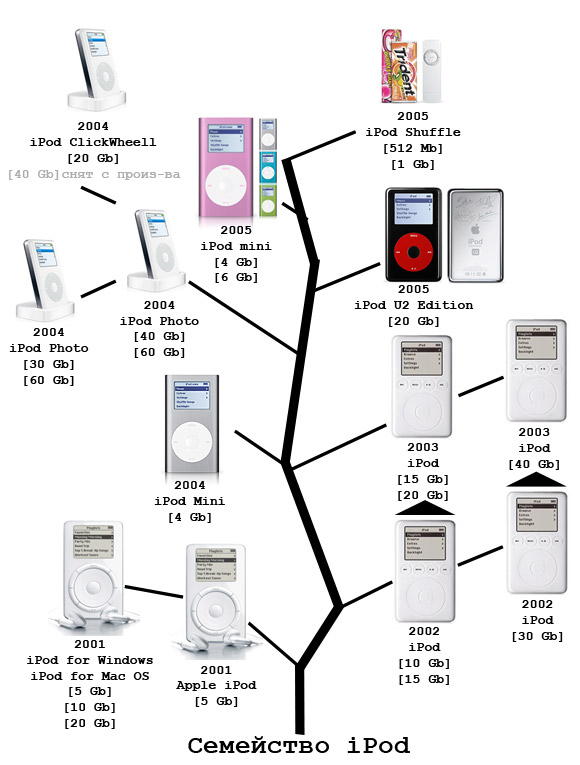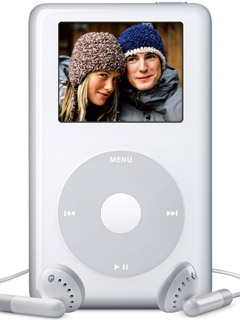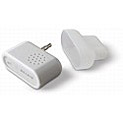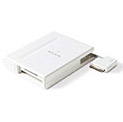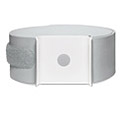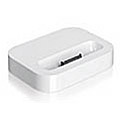Since the advent of the first personal player held for nearly four decades. From beginning it was the cassette Walkman, then the mid 90-ies were first Diskman, and further branches of the tree of personal devices to play music started to grow faster and faster. One of the main incentives for the development of the industry was a new format for storing audio - MPEG1 Layer 3, more commonly known as MP3. This format is allowed to store audio information compressed into dozens of times and opened space for new developments in pleerostroeniya. First and foremost, the developers have tried to increase the amount of information provided on the device - no one likes to carry around a few cassettes or CDs. Were natural and the downward trend in the size and weight of devices - the smaller and lighter than the player, the better. Well, of course, were of great importance Runtime. Ceychas the market offers dozens of varieties of players: cluster, disk, disk with the ability to play compressed files (MP3 and others), with memory cards as storage media (CF, SD, MMC), a Flash-memory. Crowned by a variety of players with hard disk for data storage. One of the pioneers of HDD-pleerostroeniya was at one time Apple iPod. Since then, he firmly holds the palm of leadership in its class.
Apple iPod: Do you remember how it all began ...
Presenting your attention the family tree of the family iPod and smoothly move on to the glorious history of the race.
Snow-white body with chrome back plate, a minimum of controls (wheel and five buttons - one in the center and four around the circumference) and large easy to read screen (5.2 cm diagonal, 160x120 pixels) with white backlight - Apple designers have tried to make the first iPod simple and attractive.
 |
| Apple iPod - a pioneer |
What distinguishes the first iPod model in October 2001 and sets him apart from many similar devices, he: - 5GB of hard drive size, accommodating about 1000 songs (at a bitrate 160kbit/sek)
- the ability to play compressed and uncompressed files - wav, aiff, mp3, AAC (It should be noted that Apple pioneered the introduction of the format AAC, surpassing the popular MP3 format for audio quality, obtained after compression)
- convenient operation by rotating the wheel and arranged in a circle in the center of the wheel control keys
- easy menu navigation (browser), flexible sorting of songs (artist, author, album, genre, alphabetical order, the name of the playlist)
- high-quality DAC and amplifier 60mV
- qualitatively implemented equalizer with a set of ready-made presets
- high-end headphones
- remote control unit
- promising FireWire port with data transfer rates up to 400Mbps for synchronization and charging the internal battery (including charger from the computer)
- 12:00 battery life thanks to lithium-polymer battery
- small for players of that class sizes (Apple has pioneered the use of hard disk format 1,8 "in the player before the iPod, these discs were installed only in subnotebooks)
- built-in organizer, which includes an address book with the ability to synchronize with your computer address book, calendar, with notification of designated events (alarms) and the clock with the ability to change time zone
- built-in game - klasschesky "Arkanoid" - a simple game that can delay a player for a few hours
- and, of course, also possible to use it as an external drive for any information until the boot from his operating system.
iPod had access to the remote control and headphones (3.5 mm mini jack with additional external contacts for the remote), a standard 6-pin FireWire port and switch the key lock. Headphones can be connected directly or via remote control. In addition to the remote and earphones included holster with a belt clip, FireWire cable and power supply for battery charging. The dimensions of the first iPod accounted for - 100x62x18 mm, weight was only 184 grams. The first iPod was available only to users of computers Macintosh, framed-in FireWire. He has worked with appeared shortly before his iTunes, and can sync to playlists, or manually. As the file system used by HFS, and, with the first iPod was even possible to boot a computer. PC users could only envy ... However, this omission was quickly corrected - the next version of iPod, which appeared six months after the first, has already included two options - iPod for Windows and iPod for Mac OS. External changes the second-generation iPod has not undergone. However, file system, iPod for Windows was FAT32. Included with the player instead of the iTunes program was Jukebox for Windows, which was designed to replace iTunes. It is worth noting that any of this generation iPod is easily converted from one version to another. In addition, the new iPod Touch got a scroll wheel instead of a mechanical and became available in versions of 5GB, 10GB and 20GB later. The latter became thicker than 3 mm due to the greater thickness of the new 20 gigabyte drive. FireWire connector is the same, but I got the protective cover which protects it from dirt and moisture. Shortly thereafter, created the first version of iTunes for Windows - and now PC users could enjoy the convenience and synchronize music c iPod. Time passed, the popularity of iPod has grown and now, after six months, there was a third-generation iPod - thinner, lighter, capacious, comfortable and functional. They are distinguished by a new more rounded ergonomic performance of the case, the control buttons were made separately from the wheel and got their lights.FireWire connector has been moved to the bottom of the case and replaced with a universal flat multi connector with a rubber plug, connector for remote submitted separately from the headphone plug. From the menu, added three more games, the ability to store text (and voice) notes.
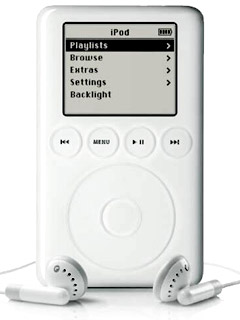 |
| Apple iPod - the third generation |
And another prominent feature allocates a new iPod - thanks to the port configuration and the updated version of the software, the player was able to sync via widely distributed in the PC port USB 2.0, which are equipped with all modern computers, as well as connecting the masses of additional devices, which will tell the end of this article. Optionally, you could buy a combined USB + FireWire cable and transfer data through it - for computers without FireWire. Third-generation iPod includes models with discs 10, 15 and 30 GB. It took another six months and a ruler, "recovered" by 15, 20 and 40 GB, respectively - the production of hard disks is not standing still. But a single charge of third-generation iPod missing for a maximum of 8 hours. This was attributed to the transition to a more subtle batteries - something that in fact had to sacrifice in favor of reducing the size.
iPod mini goes to the people ..
But even at this designers and developers Apple has not stopped. In early 2004, was announced the new iPod mini. This player was smaller than their earlier counterparts by an inch in width and height, the thickness is about two-thirds of the 20-gigabyte iPod and had a drive of 4 GB. Design is also very different - iPod mini has a color (including options for its implementation were the words: blue, pink, green, silver, gold).
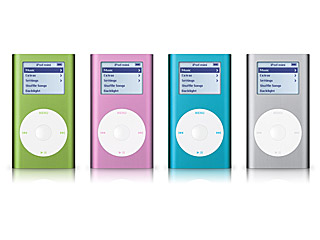 |
| iPod mini - a separate branch of |
Controls were again changed in favor of downsizing - the buttons were now no where else but on the wheel (ClickWheel). Inside it was the same as iPod, only drives it has used a different format. The player has already supplied with two cables - USB and FireWire. Now it is possible not only sync via USB, and battery charging. Demand for the iPod mini was so large that, for example, in Russia, the official delivery began only four months after the official start of sales, and even long after leaving the iPod mini a scarce commodity.
iPod ClickWheel
But as time goes on, and here in mid-2004 Apple updates and a regular iPod. This is now the fourth generation, code-named iPod ClickWheel. Yes, management, designed for the iPod mini, almost everyone had to taste, and all the iPod now has a button on the Wheel. Harddrive - 20 and 40 GB.
 |
| iPod ClickWheel - the fourth generation of players |
But that's not all the changes. Now the iPod has started to support two formats of music. First - in-house development of Apple - Apple Lossless Codec, allowing (as the name implies) to compress the audio stream without noticeable loss of quality. Second - Audible - the format is widely used for storage and sale of electronic audio books. Chevertoe generation also had the opportunity to charge from USB, and manned by two cables as well as the iPod mini.Well, another model of the fourth generation deserves special attention - iPod U2 Edition. This is a standard 20-gigabyte iPod, but in black and red version, looks a bit shocking on the background of bright colors other iPod. On the reverse side of the body flaunt autographs musicians U2, and set as an added bonus is attached coupon to purchase music through the online store Apple Music Store.
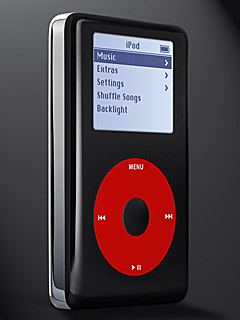 |
| iPod U2 Edition |
iPod Photo: not just music ...
It would seem that there is nothing more surprising? An-no! And here comes iPod Photo, equipped with a color screen capable of playing up to 65,000 colors with built-in drives of 40 and 60 GB and a battery that provides up to 15 hours of battery life with the possibility to show a slideshow with music directly from your iPod on home television and video equipment via cable S-Video. Now you can not only store photos on it, but watch them on internal or external screens. This is another advantage of the device greatly simplifies the demonstration images, even where no computer.
And here in the yard in 2005 - and again the family of iPod updates. Firstly, the discontinued 40GB iPod. Secondly, iPod Photo 40GB replaced by a more subtle iPod Photo 30GB - in connection with the appearance of a thin 30-gigabyte drive again played the role of the desire to decrease in size. Thirdly, there were iPod mini 6GB.
iPod Shuffle: the concept of change ...
And another new feature - the first Flash player from Apple, called the iPod Shuffle ... the size of a pack of chewing gum capacity of 512MB or 1GB. He is somewhat distracting from the concept of iPod, because as the carrier of information it appears Flash memory, but the basic idea remains the same. No screen, no scrolling, no remote, not an organizer, clock, calendar, equalizer, games, notes ...
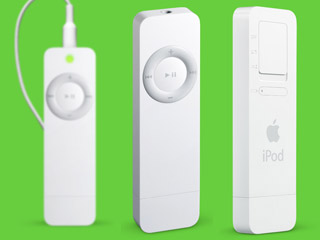 |
| iPod Shuffle - the first Flash-player from Apple |
But there is still the same high quality and natural sound, the same ease of operation, and the combination of music storage and data - now as an ordinary Flash Drive. Title Shuffle, too, pardon the pun, is not accidental. On all iPod has an option to play songs in random order, but for iPod Shuffle - this is the main way of working. And far from being the worst. After compiling collections of favorite songs is inherent in every person, and the random selection while playing for many people makes the plays more attractive. Well, if that option is not required, then the play is in the order drawn up by the user playlist.
For dessert,
And now that the store for all happy owners of iPod "for dessert" - about the accessories. Apple developers have tried to make the player not only convenient, useful, versatile, and affordable. In essence, the classic iPod is a complete system kernel, and include only what is necessary, but always ready to expand and add. If you need a voice recorder - Belkin Voice Recorder gives you the ability to make voice notes.
If traveling with a digital camera and a little memory, using the Belkin Media Reader can discard information from memory card to your iPod.
If you want to listen to your iPod in the car - at your service weight neurotransmitters (transmitters of music from an iPod to avtomagnitollu in FM-band) or adapters in the tape.
If you lead an active life (sports, fitness) - There are special devices for attaching your iPod to your hand - for example, iPod mini Armband (at the time of this writing, iPod mini Armband has been discontinued. - Ed.).
If you go hiking and have nowhere to charge the iPod, Belkin Battery Pack will enable 12-hour battery life from simple battery.
If you want a more comfortable work - iPod Dock simplifies connecting your iPod to your computer.
Want to make part of the iPod home stereo system - will help you high quality cables and wireless remote control.
Well, of course, a variety of cases, screen protector, charger connector from the cigarette lighter, even a nozzle with a flashlight and laser pointer. There are devices that turn the iPod into a separate home or mobile stereo system - for example, JBL OnTour (Portable Active speakers with the possibility of battery power) or the JBL OnStage, combines iPod Dock and powerful sound reproduction.
Certainly, great players will appear more and more new accessories - the possibilities iPod is far from exhausted.
iPod in copyright protection, or some of the features of famous players
Finally dwell on one particular device from Apple - the way music storage. Since the West is highly developed protection of copyrights, iPod "attached" to a single library iTunes, that is, when connecting to the "alien" computer music from the iPod is not so easy to get ... On all new iPod is clearly printed on the packaging: "Please do not steal music!" But what if you want to move their home library from one computer to another (eg from home to work)? There is a way. The first method - write music on the hard disk. You can not listen to it in passing, but it will be rescheduled without question. The second way - at least "fair". The fact that the sound files on your iPod is stored in a special hidden folder. In the same folder placed and service information, such as playlists. Enough by the operating system to find this folder - and then you get full access to its content. However, the Internet already has the mass of ready means for extracting music from the iPod - PodWorks, Get iPod and other similar programs. All these applications can be found through versiontracker.com. Yet we hope that you will not abuse these tools - the people who create good music, worthy of gratitude (including financial).
Indications for Use
Each of the new iPod is designed for its user. We will try to briefly describe each of them from this point of view. Let's start with the youngest and most representative of a miniature family - iPod Shuffle. This player is the ideal choice for young energetic people, especially children and adolescents. Its main features - simplicity, high reliability (absence of moving parts), ease and at the same time, inherent in all iPod sound quality. Pod mini - very classy, very elegant, the most striking of all the iPod. Its functionality is lower than that of the classic iPod (not supported by accessories such as Voice Recorder and MediaReader), but this player is perfect for those who appreciate the elegant and fashionable appearance, small size and maximize battery life. The new iPod mini this time increased to 18 hours. If you want to get "real" iPod with a large repository of music and information support for all the accessories, and you do not need a color screen and photo display or slide show, then iPod ClickWheel will become your best solution. Oh, and if you can not do without the slide show, a huge music library, storage, color screen and increased operating time as compared to the classic iPod, you maximalist or amateur hi-end devices, then you can hardly resist the iPod Photo.
A joyful present and bright future of iPod
Now the remarkable life of the family are better than ever. Quite interesting is indicative of the fact that now for the release of iPod took the company Hewlett-Packard. It produces light classic iPod ClickWheel of 20 and 40 GB, seemingly no different from its "big brother" nothing but the logo HP. In Russia, such player is not officially available, so to dwell on them we did not. But the fact remains. To open Apple "gold-mine" their eye, many manufacturers, so that in the near future we will have a breathtaking competition. In the meantime, since its inception iPod remains one of the most popular digital devices in the world. This is not just a player or a mobile data storage. The family of "apple" player - a small digital world, fits in the palm, do not cease to evolve. You can not just fantasize about what awaits us, but quite clearly imagine the iPod Video, iPod DVD, iPod 3D and so on. Of course, to be continued ... The authors, translation:
Yuri Shlayfer
